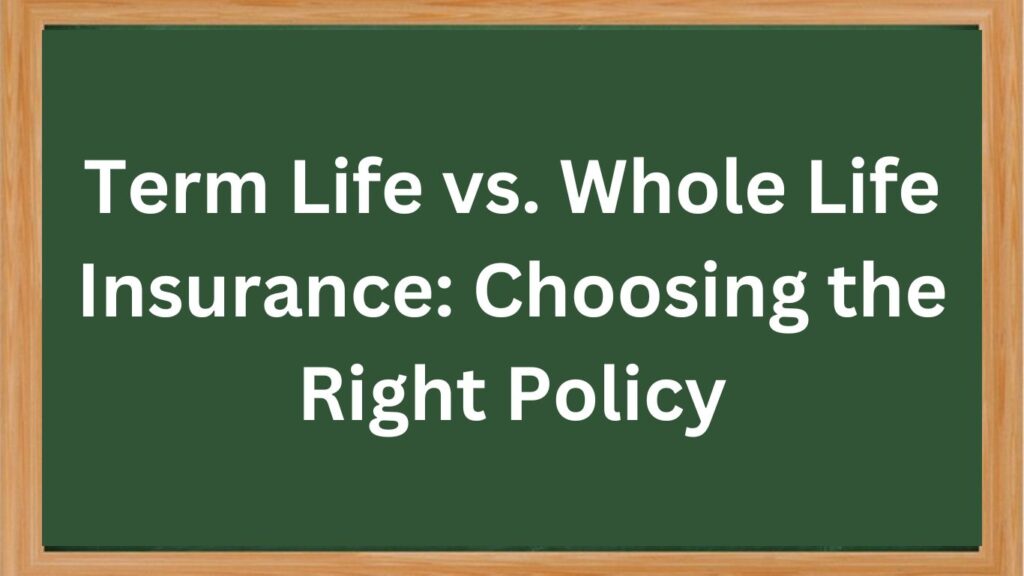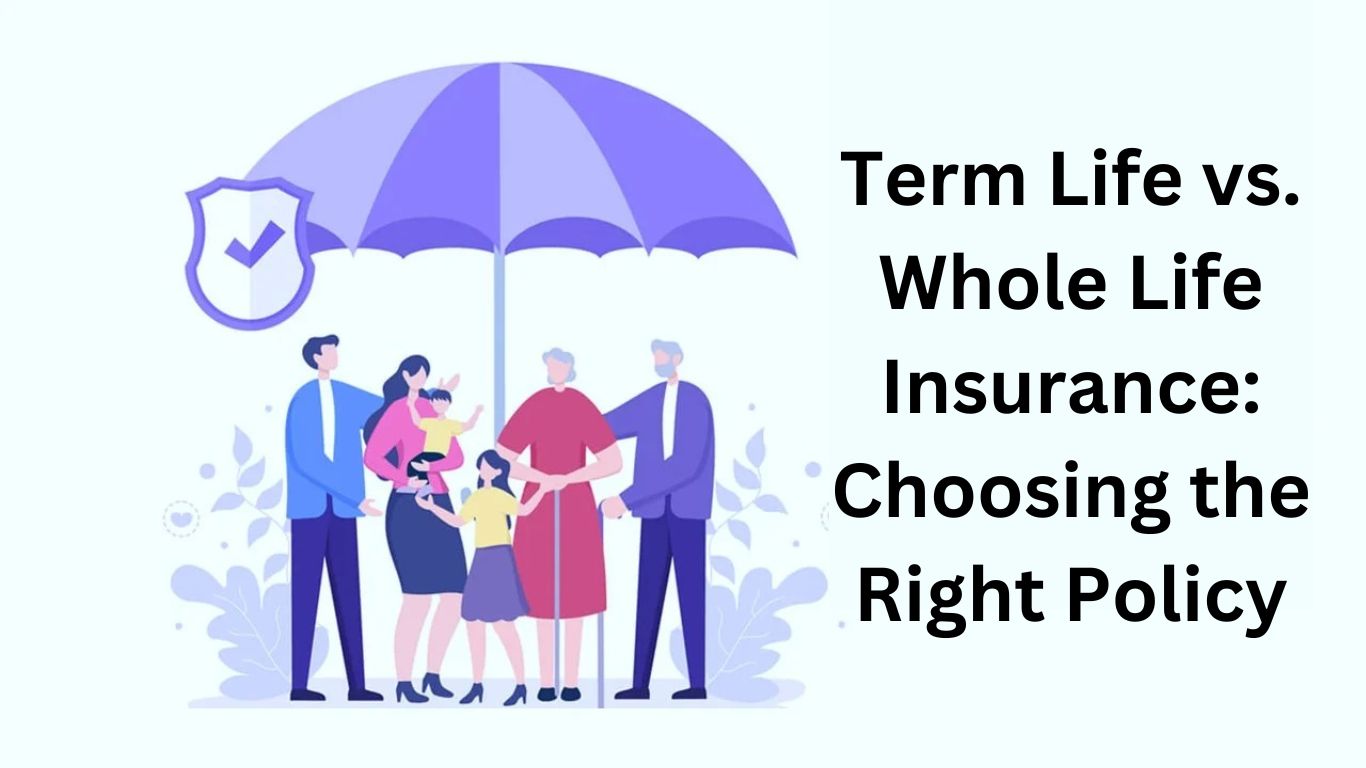Term Life vs. Whole Life Insurance: Choosing the Right Policy. With regard to disaster protection, choosing the right strategy can be an overwhelming errand. The two most normal kinds of disaster protection are term life and entire extra security. Each has its interesting highlights, advantages, and downsides, making it urgent to comprehend the distinctions to settle on an educated choice. Term Life vs. Whole Life Insurance: Choosing the Right Policy. This article will dive into the particulars of term life and entire extra security, assisting you with picking the right arrangement for your requirements.
Grasping Term Extra security
What is Term Disaster Protection?
Term life coverage gives inclusion to a predefined period, ordinarily going from 10 to 30 years. Term Life vs. Whole Life Insurance: Choosing the Right Policy. Assuming the policyholder bites the dust inside the term, the recipients get the demise benefit. Assuming that the policyholder endures the term, the inclusion closes, and no advantages are paid out.
Key Elements of Term Disaster Protection
- Affordability:
- Term disaster protection is for the most part more reasonable than entire life coverage. The expenses are lower because the inclusion is brief and there is no money esteem part.
- Simplicity:
- The strategy is clear, giving a demise benefit with practically no reserve funds or speculation components.
- Flexibility:
- Strategies can frequently be switched over completely to entire extra security without a clinical test, permitting policyholders to expand their inclusion as their necessities change.
- Fixed Premiums:
- Expenses are regularly fixed for the length of the term, giving consistency in planning.
When to Pick Term Life Coverage
Term extra security is great for people who need inclusion for a particular period, for example,
- Youthful families with restricted financial plans who need significant inclusion.
- People with a home loan or other critical obligations.
- Guardians who need to guarantee their youngsters’ schooling are supported assuming that they die.
- Individuals who look for impermanent inclusion until they resign or their monetary commitments decline.
Seeing Entire Life coverage
What is Entire Life coverage?
Entire life coverage, otherwise called super durable extra security, gives inclusion to the policyholder’s whole life, for however long charges are paid. It incorporates a passing advantage and a money esteem part that develops over the long run.
Key Highlights of Entire Disaster Protection
- Lifetime Coverage:
- Entire life coverage offers inclusion for the policyholder’s whole life, guaranteeing that a demise benefit is paid out paying little heed to when the policyholder kicks the bucket.
- Cash Value:
- A piece of the premium goes into a reserve funds part, known as money esteem, which develops at a dependable rate. Policyholders can acquire against or pull out from the money esteem.
- Fixed Premiums:
- Expenses are normally fixed for the existence of the approach, giving soundness and consistency in long-haul monetary preparation.
- Dividends:
- Some entire life approaches deliver profits, which can be utilized to lessen expenses, buy extra inclusion, or be taken as money.

When to Pick Entire Life Coverage
Entire life coverage is reasonable for people who:
- Do- Want a strategy that gathers cash esteem after some time?
- Need to leave a monetary heritage for their beneficiaries.
- Need a device for bequest arranging or abundance move.
- Favor the strength of fixed expenses and a dependable demise benefit.
Contrasting Term Life and Entire Extra security
Cost
Term Life Insurance:
- For the most part more reasonable with lower expenses.
- Ideal for frugal people requiring significant inclusion temporarily.
Entire Life Insurance:
- Higher charges because of lifetime inclusion and money esteem part.
- Reasonable for those able to pay something else for deep-rooted assurance and reserve funds benefits.
Inclusion Span
Term Life Insurance:
- Gives inclusion to a particular period (e.g., 10, 20, 30 years).
- Inclusion closes when the term lapses except if changed over completely to an entire life strategy.
Entire Life Insurance:
- Gives inclusion to the policyholder’s whole life.
- Guarantees a passing advantage is paid out, paying little heed to when the policyholder bites the dust.
Cash Worth
Term Life Insurance:
- Doesn’t collect money esteem.
- Exclusively gives a demise benefit.
Entire Life Insurance:
- Collects cash esteem that develops after some time.
- Policyholders can acquire against or pull out from the money esteem, offering monetary adaptability.
Adaptability
Term Life Insurance:
- Adaptable as far as beginning reasonableness and the capacity to change over completely to an entire life strategy.
- Restricted to the term length picked toward the beginning.
Entire Life Insurance:
- Offers monetary adaptability through cash esteem aggregation.
- Expenses and advantages stay predictable, giving security.
Settling on the Ideal Decision
Picking either term life or entire life coverage relies upon your conditions, monetary objectives, and inclusion needs. Here are a few contemplations to assist with directing your choice:
Monetary Objectives
- Momentary Needs:
- If you want inclusion for a particular period, for example, until your kids move on from school or your home loan is paid off, term extra security might be the better decision.
- Long haul Planning:
- Assuming that you look for a strategy that gives long-lasting security, constructs cash worth, and offers monetary adaptability, entire life coverage is possibly more reasonable.
Financial plan
- Affordability:
- If you are on a limited financial plan yet need huge inclusion, term disaster protection gives a reasonable arrangement.
- Eagerness to Invest:
- On the off chance that you are ready to put more in your insurance contract for deep-rooted advantages and reserve funds, entire disaster protection is a practical choice.
Risk Resilience
- Low Risk:
- Term extra security has no speculation part, making it direct and okay.
- Moderate Risk:
- Entire disaster protection includes an investment funds part that develops after some time, offering likely profits and monetary advantages.
Future Requirements
- Impermanent Coverage:
- Assuming your requirement for protection is transitory, term extra security offers inclusion for the span you want.
- Long-lasting Solution:
- For long-lasting inclusion with added monetary advantages, entire extra security gives a complete arrangement.
End
Term extra security is an incredible decision for those looking for reasonable, brief inclusion, while entire life coverage offers long-lasting insurance with the additional advantage of money esteem amassing. By surveying what is happening, long-haul objectives, and inclusion needs, you can pick the arrangement that best accommodates your conditions. Working with a proficient insurance specialist can likewise assist you with exploring the choices and select the most fitting extra security contract for your interesting necessities.
